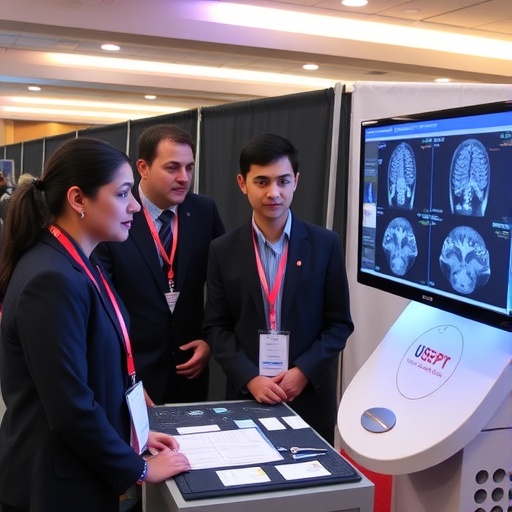In the evolving landscape of cancer treatment, the convergence of diagnostic and therapeutic strategies through nuclear medicine is ushering in a new era of precision oncology, a field known as theranostics. This transformative approach combines the power of molecular imaging with targeted radionuclide therapy, enabling clinicians not only to detect malignancies with unprecedented accuracy but also to deliver personalized treatment directly to cancer cells. Recent advances, as detailed by Gandhi, Alaseem, Deshmukh, and colleagues, highlight how theranostics is poised to redefine the paradigms of cancer care by integrating cutting-edge nuclear medicine techniques.
The fundamental premise of theranostics lies in its dual capacity to diagnose and treat disease using the same molecular agents. Radiolabeled compounds that selectively target tumor-specific markers are employed first for imaging, allowing physicians to precisely map the extent and biological characteristics of cancer. Once the tumor is characterized, these agents can be modified or paired with therapeutic isotopes to administer localized radiation therapy. This targeted approach minimizes damage to healthy tissue, thus reducing side effects and improving treatment efficacy.
At the heart of theranostics are biomolecules such as peptides and antibodies engineered to home in on receptors or antigens uniquely overexpressed on cancer cells. These vectors are conjugated with radionuclides suitable for both imaging and therapy, including isotopes emitting gamma rays for detection or beta and alpha particles for cytotoxic effects. For instance, in neuroendocrine tumors, somatostatin receptor-targeting peptides labeled with gallium-68 have revolutionized diagnostic imaging, while lutetium-177 conjugates provide potent therapeutic options.
Recent breakthroughs have further expanded the application of theranostics beyond traditional tumor types. Prostate-specific membrane antigen (PSMA) ligands labeled with positron-emitting isotopes have dramatically enhanced prostate cancer staging accuracy. Therapeutic use of PSMA-targeted radionuclides is demonstrating promising clinical outcomes, particularly for metastatic castration-resistant prostate cancer. These innovations have catalyzed a broader exploration of targets such as fibroblast activation protein, HER2 receptors, and other cancer-specific biomarkers.
The precision offered by nuclear medicine theranostics extends to the ability to assess treatment response in near real-time. Functional imaging biomarkers facilitate early evaluation of therapeutic efficacy, allowing dynamic adjustments in treatment plans. This contrasts starkly with conventional imaging modalities that primarily capture anatomical changes and often reveal response weeks or months later. Consequently, theranostics embodies an adaptive strategy tailoring patient management to evolving tumor biology.
Moreover, the integration of advanced imaging techniques such as PET/CT and PET/MRI enhances the spatial resolution and quantification capabilities, enabling comprehensive tumor characterization. Innovative radiopharmaceuticals are being developed with optimized pharmacokinetics and improved tumor-to-background ratios, further refining diagnostic precision. Parallel advances in dosimetry and personalized radiation dosing underline the necessity of computational tools to maximize therapeutic index while ensuring patient safety.
Safety profiles of theranostic treatments have generally been favorable, with toxicity concentrated primarily in organs expressing the target antigen or involved in radiopharmaceutical clearance. Bone marrow suppression, salivary gland damage, and renal toxicity remain critical considerations, prompting research into protective agents and dose optimization strategies. Continuous monitoring and post-therapy imaging are integral to managing and mitigating adverse effects.
The prospect of combining theranostic approaches with immunotherapies and other systemic treatments offers another frontier in oncology. Synergistic effects could potentially overcome resistance mechanisms inherent in monotherapies and elicit durable responses. Clinical trials combining radioligand therapy with immune checkpoint inhibitors are underway, aiming to harness the immune-modulating properties of radiation-induced tumor cell death.
Theranostics also advances the concept of personalized medicine by capitalizing on molecular diversity within and between tumors. Heterogeneous expression of target antigens poses challenges but also opportunities for multi-targeted or cocktail radionuclide therapies tailored to patient-specific tumor profiles. Incorporating genomic and proteomic data can further refine the selection of theranostic agents and optimize timing and sequencing of interventions.
Logistical and economic considerations accompany the clinical integration of theranostic nuclear medicine. Production of radionuclides and radiopharmaceuticals requires sophisticated infrastructure and strict regulatory compliance, factors that influence accessibility and scalability. However, the cost-effectiveness of precise, targeted treatments—avoiding ineffective therapies and reducing hospitalization—may offset these initial investments over time.
Educating healthcare providers and patients about the capabilities and limitations of theranostic strategies is critical for widespread acceptance. Multidisciplinary collaboration among oncologists, nuclear medicine specialists, radiopharmacists, and medical physicists is essential to harness the full potential of these technologies. Scientific societies and regulatory agencies are increasingly recognizing the importance of standardized protocols and guidelines to ensure consistent practice and optimal patient outcomes.
Looking ahead, the integration of artificial intelligence and machine learning in theranostic imaging and dosimetry holds promise to enhance diagnostic accuracy and therapeutic precision. Automated image analysis and predictive modeling could expedite decision-making and identify novel radiotracers or combinations with improved efficacy. Personalized theranostics may ultimately evolve into a closed-loop system, continuously adapting treatment in response to tumor changes detectable through molecular imaging.
In summary, the era of theranostics in nuclear medicine marks a pivotal shift toward precision oncology, leveraging molecular targeting to combine accurate diagnosis with tailored therapy. The research by Gandhi et al. underscores both the scientific advances and clinical promises inherent in this approach, highlighting ongoing innovations that are rapidly transforming cancer care paradigms. As theranostic techniques mature, they stand to significantly improve patient outcomes by delivering safer, more effective, and highly individualized treatment strategies.
Subject of Research: Theranostics in nuclear medicine for precision oncology
Article Title: Theranostics in nuclear medicine: the era of precision oncology
Article References: Gandhi, N., Alaseem, A.M., Deshmukh, R. et al. Theranostics in nuclear medicine: the era of precision oncology. Med Oncol 42, 498 (2025). https://doi.org/10.1007/s12032-025-03061-0
Image Credits: AI Generated
Tags: dual diagnostic and therapeutic strategiesengineering biomolecules for cancer targetinglocalized radiation therapy benefitsminimizing side effects in cancer treatmentmolecular imaging techniquesnuclear medicine advancementspersonalized cancer treatmentradiolabeled compounds in cancer careredefining cancer care paradigmstargeted radionuclide therapytheranostics in precision oncologytumor-specific markers detection




